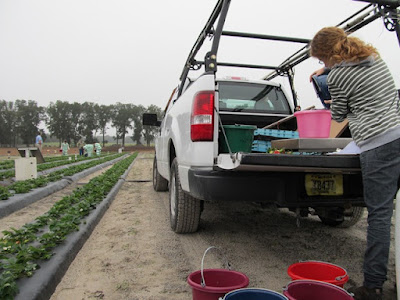The new year begins at the Plant Science Research and Education Unit (PSREU) in Citra, FL, with harvest work on graduate student
Maria Zamora’s project researching the optimization of sprinkler irrigation for
cold protection in strawberries.
Year two
Now in its second year, preparation for this study was initiated last fall. In late October, the overhead sprinkler irrigation system used for cold protection and plant establishment was re-erected.
 |
| Impact sprinklers used in overhead irrigation |
Soon after, the
planting beds, plastic and drip line irrigation were laid out by the PSREU
field crew. Beds in place, final rotation rate tests on the impact sprinklers
were conducted to ensure similar application patterns.
Proper overhead
irrigation is critical not only for cold protection, but also for plant health
during the establishment period following transplant to the field.
This study is investigating how reducing sprinkler water pressure for cold protection, and thereby reducing water-use, will affect fruit yield in strawberries.
 |
| Pressure on the main line |
 |
| From front to back: plots 11 to 15 |
 |
| Transplanting day: out of the cold and into the cold |
 |
| Kizzy Boyer preps the rows |
 |
| New transplants wilting in the sun |
Although the plants looked a little worse for wear after transplanting, they recovered nicely just in time for the Central FL temperature drop.
 |
| Step 1: pollinate |
 |
| Step 2: fruit! |
 |
| 12/22/12: impacts at dawn |
 |
| On-site weather stations collecting data and assisting in cold protection |
The other plots function off
a simpler automated cold protection set-up. FAWN alerts keep everyone informed
as to dates and severity of upcoming freezes.
In late December I had the unexpected good fortune of welcoming
a freeze in the wee hours of the morning.
My task: gather pressure readings at various points in the overhead system to confirm the plots were watering as expected.
Fruit harvesting began early this month. Twice a week, fruit
is harvested by plot number and location within the plot, then weighed as marketable and unmarketable (cull). Harvests (and a few more freezes?) will continue until mid-March.
 |
| Sara on scale duty |
Pies, anyone?
The strawberries from these early harvests are especially sweet. On my next South Florida visit, there will be samples in tow!
The strawberries from these early harvests are especially sweet. On my next South Florida visit, there will be samples in tow!
 |
| Sweet: a king's ransom in strawberries! |









Man, wish I had some of those berries!!!!!!!!!!!!
ReplyDelete